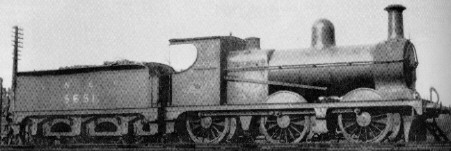The Parker & Pollitt J9 (GCR Classes 9B & 9E) 0-6-0 Locomotives

In 1891 Parker adapted his existing Manchester Sheffield & Lincolnshire Railway (MS&LR, later GCR) J13 goods locomotive, by fitting 3in larger wheels. Classified as Class 9B by the MS&LR, twenty five engines were built in 1891 by Neilson & Co. The next order developed the design further and used Stephenson valve gear to become GCR Class 9D (LNER J10). Pollitt became the MS&LR's Locomotive Superintendent in 1894, and initially reverted back to the 9B's Joy valve gear. Pollitt's new locomotives had enlarged axle journals and crank pins, as well as a stronger crank axle. Only six of these engines were built in 1894-5 before Pollitt switched back to the J10 design with its Stephenson valve gear. This final batch was given the GCR classification of 9E. The LNER classed both the 9B and 9E engines as Class J9.
All of the J9s were built with round-topped fireboxes. Robinson fitted boilers with Belpaire fireboxes between 1912 and 1920. These new boilers were to the GCR's new "Standard No. 1 Belpaire firebox boiler" and had the same basic dimensions as the original round-topped fireboxes.
The J9s were built with short cab roofs, but Robinson extended the roofs and fitted pillar supports on most of the J9s. Some of the J9s kept their short roofs until withdrawal.
About the only thing changed on the J9s by the LNER, was the chimney. At Grouping (1923), the J9s were usually fitted with Robinson chimneys, although some still had earlier stovepipe chimneys. The LNER transferred a number of J9s to Scotland in 1924-5. The chimneys exceeded the North British Railway's (NBR)loading gauge but they were initially left unchanged. This oversight appears to have been due to an error in the engine diagram. In 1925, a number of the Scottish J9s received NBR chimneys. Eventually most would receive the LNER 'flowerpot' design, although No. 5664 is known to have been withdrawn with its NBR chimney still intact. From 1927, the LNER classified the short chimney J9s as J9/2, and the unaltered J9s as J9/1.
The J9s were initially used on the main line coal and goods trains between Manchester and Grimsby. The introduction of more powerful J11s in 1901 quickly displaced the J9s to less important duties. Many of the J9s were moved to the west of the GCR system, including North Wales. In 1921, the J9s were allocated to Northwich (27) and Gorton (4).
With the introduction of large numbers of war-surplus ROD 2-8-0 (LNER O4) locomotives after Grouping (1923), the J9s became redundant on the former-GCR lines. Between December 1924 and August 1925, twenty six J9s were moved to Scotland to replace very old J31, J32, and J34 locomotives. The Scottish J9s were mainly used on local goods and mineral traffic in the Central Lowlands, and they were allocated to: Kipps (10), Parkhead (8), Bathgate (4), and Polmont (3). The Scottish engine crews did not like the J9s, mainly due to a "poor brake" and the use of Joy valve gear. The six locomotives that stayed in England were allocated to Northwich, where they remained until withdrawal.
All of the J9s were withdrawn between 1930 and 1936. The boilers from the Scottish J9s were usually sent to Gorton for use as spares. The boiler from No. 5659 was used as a stationary boiler at Inverurie, and the frames from Nos. 5656 & 5666 were used as boiler carriers at Cowlairs Works.
Technical Details
| Cylinders (x2): | (inside) | 18x26in. |
| Motion: | Joy | |
| Valves: | slide | |
| Boiler: | Max. Diameter: | 4ft 4in |
| Diagram No.: | 21 | |
| Pressure: | 160psi | |
| Heating Surface: | Total: | 1063 sq.ft. |
| Firebox: | 99 sq.ft. | |
| Tubes: | 964 sq.ft. (190x 1.75in) | |
| Grate Area: | 18.3 sq.ft. | |
| Wheels: | Coupled: | 5ft 1in |
| Tender: | 3ft 9in | |
| Tractive Effort: | (@ 85% boiler pressure) | 18,781lb |
| Wheelbase: | Total: | 38ft 9in |
| Engine: | 16ft 6in | |
| Tender: | 13ft 0in | |
| Weight (full): | Total: | 78 tons 4cwt |
| Engine: | 40 tons 18cwt | |
| Tender: | 37 tons 6cwt | |
| Max. Axle Load: | 15 tons 10cwt |
Preservation
None of the J9s survived into preservation.
Models
DJH produce a OO gauge (4mm scale) kit of the J9 locomotive.